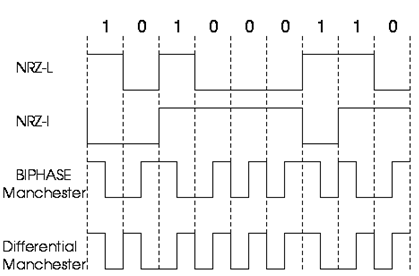Types of Encoding
o Biphase-manchester: In this transition is from high to low in middle of interval = 1 and Transition from low to high in middle of interval = 0
o Differential-manchester: There always be a transition in middle of interval. No transition occurs at beginning of interval=1 and Transition at beginning of interval = 0
o 4B/5B Encoding: In Manchester encoding scheme, here transition after every bit. It shows that we must have clocks with twice the speed to send same amount of data as in NRZ encodings. In different words, we may say that only 50 percent of the data is sent. This performance factor can be hugely improved if we use a better encoding scheme. This method could have a transition after fixed number of bits instead of every other bit. Similar to if we have a transition after every four bits, and then we will be sending 80% data of actual capacity. This is a major improvement in the performance.
This scheme is known as 4B/5B. So here we convert four bits to five bits, to make sure at least one transition in them. The fundamental idea here is that five bit code selected must have:
- one leading 0
- no more than two trailing 0s
Thus it is ensured that we can never have more than three consecutive 0. Now these five bit codes are transmitted by taking NRZI coding thus problem of consecutive 1s is solved.
The exact transformation is as follows:
|
4-bit Data
|
5-bit code
|
4-bit Data
|
5-bit code
|
|
0000
|
11110
|
1000
|
10010
|
|
0001
|
01001
|
1001
|
10011
|
|
0010
|
10100
|
1010
|
10110
|
|
0011
|
10101
|
1011
|
10111
|
|
0100
|
01010
|
1100
|
11010
|
|
0101
|
01011
|
1101
|
11011
|
|
0110
|
01110
|
1110
|
11100
|
|
0111
|
01111
|
1111
|
11101
|
Of the remaining 16 codes there are 7 invalid and others are used to send some control information like line idle (11111), line dead (00000), Halt(00100) etc.
There are other variants for this scheme viz. 5B/6B, 8B/10B and a lot more. These have self suggesting names.
o 8B/6T Encoding: In the above schemes, we have used 2/3 voltage levels for a signal. But we could overall use more than three voltage levels so that more than one-bit could be sent over a single signal. Similar to if we use 6 voltage levels and we use 8-bits then the scheme is called 8B/6T. Clearly here we have 729(3^6) combinations for signal and 256(2^8) combinations for bits.
4B/5B Encoding: Here we have three voltage levels: middle, upper and lower
o Representation 1: Middle level =0, Upper Lower level =1 ,such that consecutive 1's will be shown alternately on upper and lower levels.
o Representation 2 (pseudo ternary): Middle level =1, Upper and Lower level=0
Email based Computer Science assignment help - homework help at Expertsmind
Are you searching Computer Science expert for help with Types of Encoding questions? Types of Encoding topic is not easier to learn without external help? We at www.expertsmind.com offer finest service of Computer Science assignment help and computer science homework help. Live tutors are available for 24x7 hours helping students in their Types of Encoding related problems. We provide step by step Types of Encoding question's answers with 100% plagiarism free content. We prepare quality content and notes for Types of Encoding topic under computer science theory and study material. These are avail for subscribed users and they can get advantages anytime.
Why Expertsmind for assignment help
- Higher degree holder and experienced experts network
- Punctuality and responsibility of work
- Quality solution with 100% plagiarism free answers
- Time on Delivery
- Privacy of information and details
- Excellence in solving computer science questions in excels and word format.
- Best tutoring assistance 24x7 hours